Before I begin my address to you today, I would like to show my respect and acknowledge the traditional custodians of this land, of elders past and present, on which this event takes place.
Let me also acknowledge the Member for Victoria Park, Mr Ben Wyatt MLA, and Mr Bill Johnston MLA, the Member for Cannington. I thank them both for being here today.
My subject this morning is the challenges and opportunities for Australia presented by global developments. These developments contribute to pressures in our economy, and they require an informed and considered national debate about how best to respond, in the short term and in the decades to come.
The world is undergoing tremendous structural change. While change can at times seem to be the only constant, what we are seeing today comprises both longer-term transformations and shorter-term volatility.
Longer-term drivers include the rapid pace of technological change, which has already revolutionised our lives. Add to that the challenge of sustainability, most sharply seen when we discuss climate, environment, water and food security, and the impact of demography as key parts of the world's population ages.
Global volatility and emerging Asia
One of the key long-term shifts underlying the period of transformation is the increasing share of the world's global economic weight tilting towards emerging market economies, particularly those of Asia.
To illustrate this, in the 1950s only around 15 per cent of the world's economic output was located within 10,000 km of Australia. Today, that share has more than doubled to over one-third, and it is likely to continue to rise to around half of global output by 2030.
Clearly, much of this shift is attributable to the growth of China and India - combined, these economies accounted for less than one-tenth of the global economy twenty years ago. Today, as seen in the chart, they account for over one-fifth.
While their growth paths will be volatile, due to the vulnerabilities inherent to economies in transition, the projected growth of the emerging market economies combined - which now comprise around 50 per cent of world GDP - will be around three quarters of global growth, on average, over the next five years. And our Asian neighbours are expected to provide the largest share of this growth.
Global reweighting underway
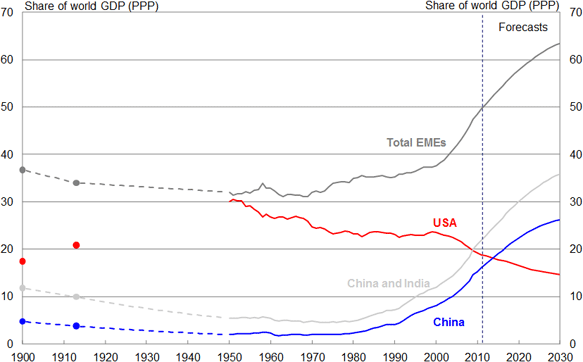
Source: The Conference Board Total Economy Database, Maddison (2010), IMF World Economic Outlook Database and Treasury.
In our region alone, these developments extend beyond China and India. Indonesia is now a larger economy than Australia (in purchasing power parity terms), while a number of other smaller emerging Asian economies are also increasing their relative weight in the global economy.
The sluggish growth, high unemployment, and fiscal sustainability pressures being faced by many of the North Atlantic economies is only adding to the extent and speed of this shift from West to East.
While short-term financial pressures in Europe have been relieved for the time being by the European Central Bank's recent policy announcement on conditional sovereign debt purchases, ultimately, this isn't enough to resolve the underlying causes of the crisis confronting much of continental Europe.
A more lasting resolution to the crisis would see euro area governments implementing the sorts of reforms that can achieve a closer banking, fiscal and political union. Structural reforms will also be required to improve competitiveness and to drive long-term growth. In the decade leading up to the crisis, the competitiveness of many European economies deteriorated significantly relative to Germany. This not only helped to fuel the crisis, it is now impeding recovery efforts. To address competitiveness issues, these economies have embarked on broad-ranging reforms in labour and other markets, as well as to the business environment. Progress has been mixed to date.
Underlying issue of competitiveness
(Euro area domestic price levels)
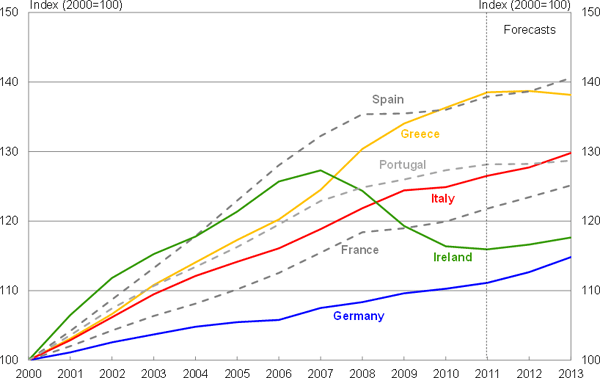
Note: Data refer to GDP deflators.
Source: OECD and Treasury.
At the same time, many of these economies are implementing significant repair to their public finances. A key risk to the successful policy implementation of these difficult fiscal and structural reforms will clearly be the extent of societal acceptance. As such, we should expect a protracted period of global uncertainty ahead.
Of course, the elephant in the room marked 'global outlook' is the risk that the United States could fall off the looming fiscal cliff at the end of 2012. Unless politicians intervene, the scheduled tax increases and spending cuts are expected to weigh heavily on growth. If that fiscal tightening goes ahead, the US economy could experience a recession in the first half of 2013 of a magnitude similar to the recession it recorded in the early 1990s.1
At the same time, failure to embark on measured fiscal consolidation risks US government debt levels rising to levels of the sort seen in Europe today.
US fiscal outlook
CBO "plausible scenario"

US federal debt held by public
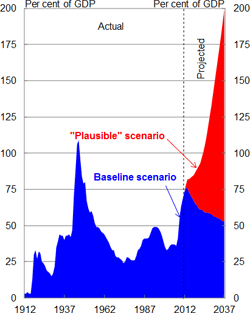
Note: Baseline scenario adheres closely to current law; the 'plausible' scenario assumes that certain policies that have been in place will continue rather than expire and that the tax-to-GDP ratio remains around its 40-year average.
Source: US Congressional Budget Office The 2012 Long-Term Budget Outlook, June 2012.
So the global economic volatility we're seeing now is emanating from a number of sources that, taken together, seem to guarantee that volatility will be a feature of the global economy for at least the next decade.
The impact on Australia: Three waves
What does all of this mean for Australia?
The consequences of the growth of emerging Asian economies can be characterised as coming in three waves. The first wave is the expansion of the mining sector that we are currently experiencing, most notably here in Western Australia. The second is the growing global demand for our agricultural products. And the third is the rise of the middle class in the Asia-Pacific region.
Let me spend some time elaborating on the first wave, before briefly outlining the second two.
The first wave, the rise in our mining sector, can itself be broken down into stages. The initial stage saw the rise in prices for our minerals that began in the early 2000s and peaked late last year. This was followed by the unprecedented rise in mining investment, and while investment won't continue to rise indefinitely, we expect strong investment this financial year and next. Only just beginning is the strong rise in extraction and export volumes stemming from that investment.
I want to reiterate here what has been picked up in the media recently: the term 'resources boom' is simplistic, because the corollary of a boom is a bust. Yes, the terms of trade are coming off, but they remain, and are likely to remain, high by historical standards. In other words, we're unlikely to see a bust - what we're seeing is a longer, more complex story than the boom-and-bust cycle of generations past.
So I would concur with R
eserve Bank Governor, Glenn Stevens, that rumours of the death of the mining sector have been greatly exaggerated. Instead of the boom-and-bust cycle, what we will see ultimately is mining becoming a much larger share of a reshaped economy. The mining sector is expected to rise from 5 per cent of gross value added in the early 2000s, to in the order of 10-12 per cent in the decades to come.
Permanently larger mining sector
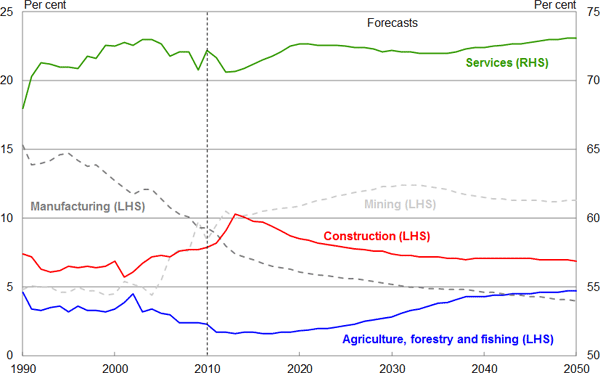
Note: Shares are the total gross value added. MMRF estimates after 2010 are spliced onto historical ABS.
Source: Strong Growth, low pollution report (2011), ABS and Treasury estimates from MMRF.
Indeed, what has been labelled as a 'boom' was, in fact, a terms-of-trade shock providing Australia with windfall gains from the sudden but sustained increase in prices for our minerals due to rapidly increasing demand, particularly from China. We have not seen such a dramatic increase in our terms of trade since the Korean War fuelled demand for Australian wool, and certainly not for such a sustained period.
Sustained higher terms of trade
(Price exports/price imports)
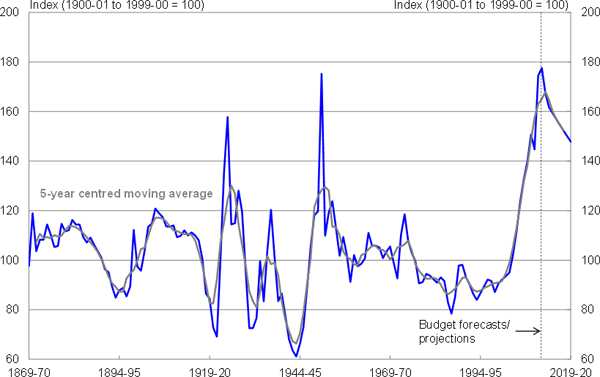
Source: ABS Catalogue Number 5206.0, RBA and Treasury.
And this terms-of-trade shock has translated into a considerable boost to our national income.
Terms of trade boosting incomes
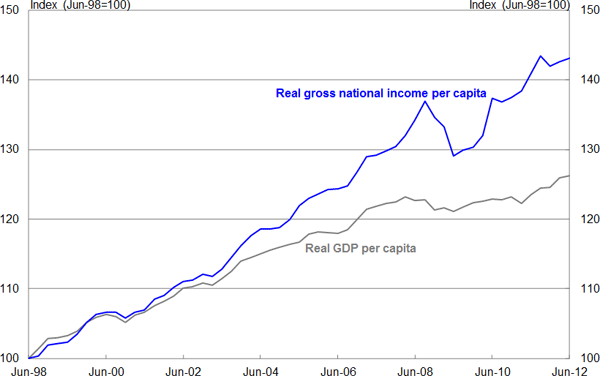
Source: ABS Catalogue Number 5206.0 and Treasury.
The higher minerals prices have also exerted pressure on our non-mining sectors by pulling resources towards the mining sector and pushing up the value of the Australian dollar. The positive side has been a reduction in the price of imported goods, from which all Australians benefit. As Glenn Stevens explained it, in 2005 a shipload of iron ore was worth the same as around 2,200 flat screen televisions. In 2010, the same shipload was worth around 22,000 flat screen TVs.
But at the same time, the high exchange rate and competition for scarce resources have hurt trade-exposed and/or labour intensive sectors, such as manufacturing and tourism.
That was the first stage of the mining story. The second is the rise in investment driven by higher prices - the expectation of continued higher prices has supported additional investment in the mining sector, both with the development of new greenfields sites and the expansion of existing projects. Mining investment is expected to reach record highs as a share of GDP in 2012-13 and remain at or close to historically high levels through to at least the middle of this decade.
Growth in mining investment and intentions
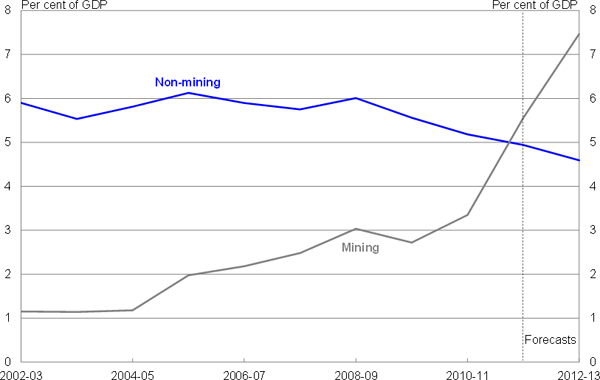
Note: Estimates for 2012-13 are from the ABS CAPEX survey, and are based on long-run average realisation ratios.
Source: ABS Catalogue Numbers 5206.0, 5625.0 and Treasury.
Beyond the peak of investment, we'll see a strong rise in extraction and export volumes - the third stage of the mining story. In terms of exports, I would add that we are already seeing another dimension to this, with the export of our mining and mining services expertise to other economies, most notably in Africa.
So the labelling of this first wave of change washing over Australia's economy as a 'mining boom' fails to capture the more complex progression of what is, in fact, an evolution in our mining sector and the reshaping of our economy.
The second wave flowing across our economy from the tidal economic shifts in Asia is in agriculture, as global demand for agricultural produce increases. We're likely to see a significant increase in demand, particularly from China, for high-end agricultural products like fruit, dairy, high-grade meat and seafood. As with the evolution of our mining sector, we are well placed to capture the benefits from this growth in global demand, but a critical issue will be how we handle the foreign investment dimensions and the obvious concerns in some parts of our community.
The third wave will be in the global growth of the middle class. The number of middle-class consumers in the Asia Pacific region is expected to grow from half a billion in 2009 to 3.2 billion by 2030. Consequently, by 2030, it is estimated that just under two-thirds of spending by the world's middle class will come from the Asia Pacific region, compared to around only one quarter today. This growing middle class will demand better services, goods and experiences.
And in contrast to the other two waves, this is not one where our natural resources and geography will give us a particular advantage. It will present both challenges and opportunities for Australia.
Challenges and opportunities for Australia
As I see it, there are three such significant challenges and opportunities for us in the coming decades.
The first challenge will be in protecting our endowment of sound macroeconomic policy frameworks and ensuring that we are not lulled into a sense of complacency about their importance. In a number of fora throughout the year, I've championed the central role these frameworks have played in the relative stability of Australian economic growth for the past two decades. This is despite Australia having faced three of the most significant - some may say the largest - shocks seen since World War II in the past decade.
The frameworks I'm talking about include our medium-term approach to fiscal and monetary policy, our market-determined exchange rate, and our reliance on market-determined price signals to move people and resources to where they are most productive and valued. Together, these have provided great flexibility to deal with the economic shocks that have come our way in recent years.
When problems arise there is always a temptation to chip away at the fundamental components of the frameworks, but resisting this temptation is critical to securing Australia's future wellbeing. For example, there have been calls lately for an artificial lowering of the dollar. What has been lost in the debate is recognition of the crucial benefits of a market-determined exchange rate as part of our macroeconomic policy framework, and the important macro-stabilising role it has played in the Australian economy.
Although the high dollar weighs heavily on some sectors, the alternative - which would be allowing the real exchange rate appreciation to be driven by higher domestic inflation - is likely to be more costly for the economy as a whole, and for the poor in particular, as we saw during the booms of the 1950s and 1970s.
A comparison of terms of trade booms
1950s boom
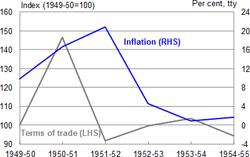
1970s boom
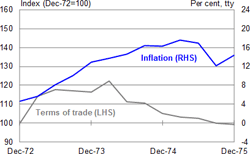
Mining boom mark I
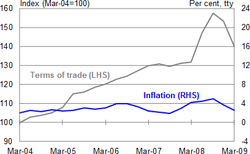
Mining boom mark II
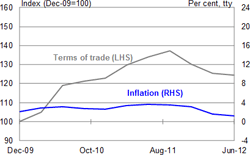
Of course, we should always aim to improve and adapt our frameworks as circums
tances change; but, in adapting them, we need to keep in place the principles of openness and flexibility that underpin them.
For example, given the growth in demand in the region, Australia's openness to foreign trade and investment will remain a critical determinant of success in this century.
We also need to ensure that our scarce resources can move quickly so that we can take full advantage of the opportunities before us. Workers, investors and entrepreneurs must be able to direct their resources according to their best judgements and in response to appropriate price signals. To ensure that price signals are good guides, we need to maintain and foster healthy competition by regulating against price distortion and supporting dynamic and efficient markets. This leads me to a presumption toward deregulation where ever feasible!
The bipartisan medium-term fiscal strategy has been another important pillar of our economic policy framework since the early 1980s; I will speak a bit more about this later.
The second challenge is that, with the likely peak in the terms of trade, future growth in living standards will now be driven by productivity growth. As seen in the chart, rising terms of trade accounted for almost half of national income growth in the 2000s. Exacerbating this, we have also now entered a period when population ageing will reduce participation in the workforce. As in much of our past history, productivity growth will be the key driver of improving living standards. As Paul Krugman notes, "Productivity isn't everything, but in the long run it is almost everything."
Contributions to growth in average incomes
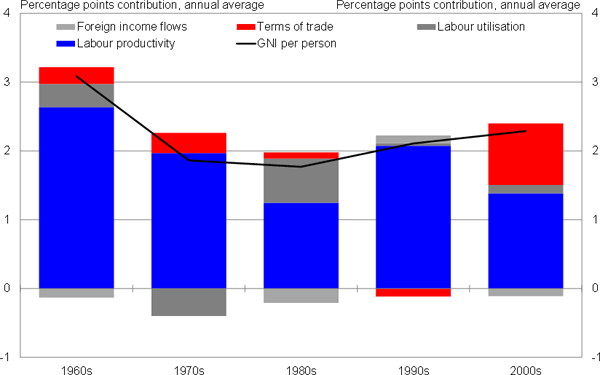
Source: Treasury calculations based on ABS Catalogue Numbers 5206.0, 6202.0 and unpublished ABS data.
Ultimately, productivity improvements will need to come from the decisions businesses take each day.
Governments at all levels also need to create an environment for productivity improvement through focusing on enablers (such as education, skills and infrastructure) and through continued efforts to remove unnecessary regulations - and COAG has a critical role here.
The third challenge lies in asking ourselves what is needed to build comparative advantage for an increasingly competitive and globalised world, where Australia's producers, exporters, and service providers will be competing with the rest of the world for the attention and custom of the Asian middle class. As I said earlier, it is nowhere pre-ordained that we should benefit from the rise of the Asian middle class.
While the comparative advantage of our abundant natural resources is obvious, there is no obvious comparative advantage in our services sector. And while global economic weight is shifting towards the Asia Pacific region, we can't count on proximity alone to deliver advantage. After all, Beijing is closer to Berlin than it is to Brisbane.
This third challenge will require significant investment and cooperation from the public and private sector; investment not only in our policy frameworks and our physical and socio-economic infrastructure, but also in our human capital. We need to ensure that our population remains among the world's most highly educated and highly skilled, but we also need to foster openness and understanding; the so-called soft skills of cultural literacy.
This third challenge, of building our comparative advantage, was also a subject for discussion at a conference - co-hosted last month by Treasury, the RBA and the IMF - on structural change and the rise of Asia.
Presenters at the conference made the point that Australians and Australian businesses need to become more proactive in Asian markets; to build recognition and understanding of their product and brand. The opportunities are huge if we can grasp them. To take one example, a lack of emphasis in the past on health care and financial service provision in the Asia region is an area of opportunity for Australian service providers.
The Asian Century White Paper, due for release shortly, was commissioned to facilitate a community discussion on how we might best seize as many opportunities as possible. It's not the whole answer but, rather, a roadmap to help us comprehend and grasp those opportunities. Indeed, it should be seen not as our concluding statement on Asia, but as the beginning of a fuller conversation about how we best position ourselves for success in the Asian century or, to be more precise, the Indo-Pacific century, sweeping from India in the West eastward across the Pacific to North America and encompassing Asia in its entirety.
Australia's economic success and perceptions
At the conference I was particularly struck by the observations of two presenters with whom I shared a panel discussion at the end of the day.
Joining Professor Ross Garnaut and me on the panel were Professor He Fan from the Chinese Academy of Social Sciences, and Masahiko Takeda of the IMF. Mr Takeda and Professor He Fan both commented on what they, as outside observers, perceived as the strange disconnect between Australia's economy and Australians' perception of it.
Despite the continually good news about our short-term and medium-term prospects from sources like the OECD and the IMF, there is considerable, persistent and, in my view, unwarranted pessimism.
It is important to keep in perspective that, as a country, we've been here before. We've experienced times in Australia's history where governments at all levels have had to face tough and uncertain economic conditions. But we have come through these periods and, indeed, have used them to improve our macroeconomic policy frameworks and build a more productive, open economy able to deliver substained improvements in living standards and wellbeing more broadly.
Second, Australia is among the world's largest economies and we can look back on 21 years of uninterrupted growth, a record unmatched by any other advanced economy over this period. Furthermore, Commonwealth finances are strong and our debt is low by international standards. The extent of confidence in the strength of Australia's public finances continues to be reflected in Australia's AAA credit rating.
In terms of household wealth, Australia has also fared very well - particularly in comparison to, say, the United States, which has seen median household wealth fall by a third in real terms from its pre-crisis peak in 2007. Real personal disposable income levels in the US and UK today stand at 4.8 per cent and 2.1 per cent above their December 2006 levels, whereas real Australian household disposable incomes have risen 24 per cent.
Real median household wealth
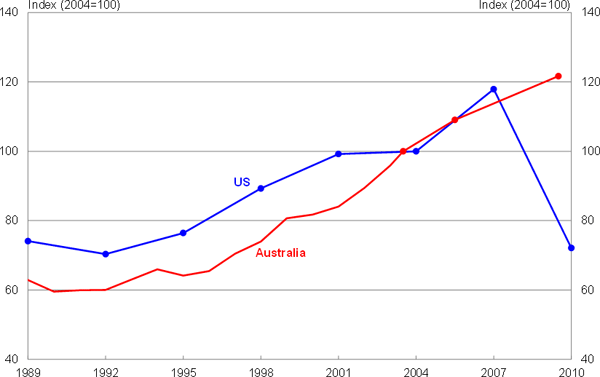
Note: Dotted data points show surveyed micro-data. Micro-data for Australian median wealth per household are not available before 2003-04 and have been backcast using macro-data on mean wealth per capita.
Sources: US Federal Reserve Survey of Consumer Finances, ABS Catalogue Numbers 5206.0, 6554.0, RBA and Treasury.
Across the OECD government debt ratios have been on an upward trend since the 1970s, despite efforts to bring the ratio down in good economic times; this is in dramatic contrast to the low levels of debt in Australia and the projected return to zero net debt in 2020-21.
Australia's relatively low net debt
(2011-2017)
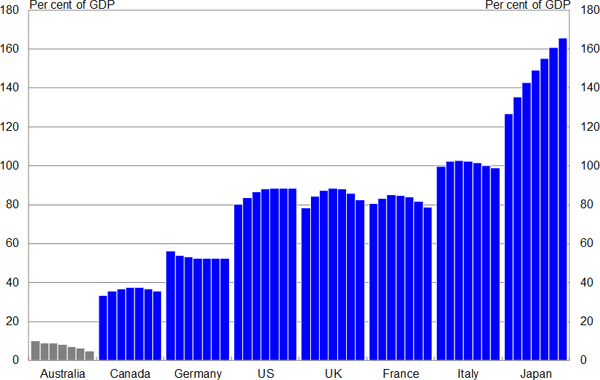
Note: Australian data are for the Australian Government general government sector and refer to financial years beginning 2011-12. Data for all other economies are total government and ref
er to calendar years beginning 2011.
Source: IMF Fiscal Monitor April 2012 and Treasury.
Our economic outlook, while vulnerable to the global volatility I've mentioned, is strong and our fundamentals are sound.
Great and growing expectations of government
One area that does require real attention is how to maintain fiscal sustainability at all levels of government in light of growing community expectations of what governments should provide.
Thanks to the enduring bipartisan commitment to fiscal sustainability that has underpinned our economy for the past three decades, the Commonwealth today is in a sound position. However, looking ahead, there are growing pressures on fiscal sustainability at all levels of government.
As a community, we need to make choices about what governments can and should provide, and how these will be funded. And my main message today is not about what these choices are but that, as a society, we must have a considered and informed national debate about these choices.
There are a number of pressures on our fiscal position.
The first is that our ageing population will mean slower rates of economic growth as the participation rate falls.
Participation among older people is increasing, but the level of participation is lower than average, meaning that as more people move into older age groups aggregate participation will decline.
Slowing GDP growth
(Average annual growth)
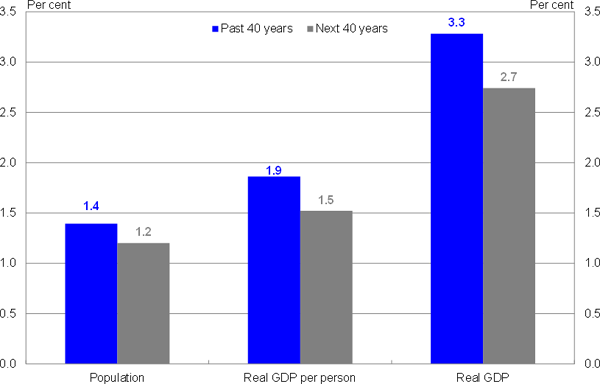
Source: 2010 intergenerational report.
Secondly, while we are getting richer, our expectations for more goods and services delivered by governments are also growing.
We know that in the next ten years we will be facing significant spending pressures, particularly in the areas of health and aged care, as our population ages and the average cost of services increases. Combined, these areas of expenditure are expected to grow faster than GDP, meaning that they will be taking up a larger share of the economy over time.
As an example, health care costs at the Commonwealth level are expected to grow five-fold in the coming decades. A significant portion of this growth will be driven by the ageing of the population. But it will also be driven by the changing nature of health service - many of us here will be expecting higher standards of aged and health care services than those received by our parents.
Total Australian government health expenditure with and without non-demographic growth
(in 2009-10 dollars)
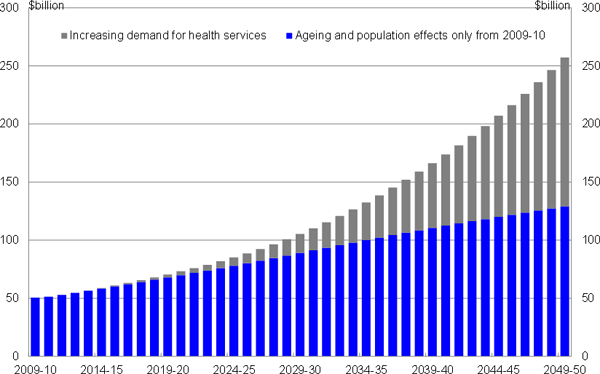
Source: 2010 intergenerational report
Compounding these pressures are community expectations that government will provide new services (the National Disability Insurance Scheme, for example) or deliver substantial reforms to existing services that could entail more spending (such as the school funding proposals).
Thirdly, at the same time that we face these increased pressures on public spending, significant structural change in the economy and global economic weakness mean that the relationship between the size of the economy and the amount of tax we collect from it is changing, too. Revenue growth has slowed and is likely to slow further. And revenues will simply not be returning to the unsustainable levels of the previous decade.
To illustrate, since the mid-2000s, due to a range of factors including the GFC, the revenue base has dramatically hollowed. The post-GFC recovery of revenue has been slower than expected, as a falling off of company tax and capital gains has been accompanied by a cautious consumer who's saving more and spending less, which affects consumption-based taxes important to the States.
Change in revenue relationship to economy
Nominal GDP
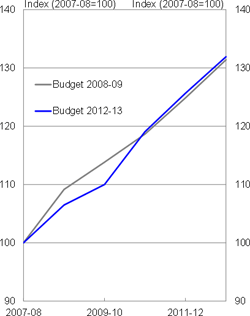
Tax receipts
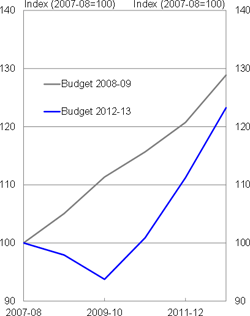
Source: 2008-09 Budget and 2012-13 Budget.
Combined, the slowing economic growth, rising expectations of government, and a constrained revenue base, are likely to force an explicit debate about the size and scope of government, both at each level of government and between the levels of government.
I see this debate being shaped by a series of questions.
The first is about what we - as a just and democratic society - want or expect our governments to provide. The incomes of Australians will continue to grow, albeit at a slower rate, and we will increasingly demand better quality goods and services. While, at times, debate has presumed that these services will always be publicly provided, this is not a presumption we can afford to make. There are many very worthy and constructive programs that governments could potentially fund. Explicit prioritisation is required on what can, and what can't, be funded by governments as opposed to individuals.
We then need to consider how governments should fund the goods and services they are to deliver. And while mention of this always creates excitement, it is truism that any increases in spending need to be funded either via higher taxes, introducing more user-pays options, and/or reducing spending on other services.
This raises an important issue for governments at both the Commonwealth and State levels: the sustainability of the tax system. We can't think about government provision of services in isolation from government revenue: the two are intrinsically connected. Therefore, we must also think about whether the tax system will continue to support the functions the community is demanding from governments, while delivering the incentives for investment in physical and human capital, innovation and participation.
Given recent pressures on tax collections, and following the Henry Review, the Commonwealth Government has been doing significant work to broaden and strengthen the integrity of our personal and business tax bases. Among many, examples include:
- phasing out the Dependent Spouse Tax Offset, which no longer reflects women's workforce participation rate;
- reforms to the tax concession for living-away-from-home allowances and benefits, since our workforce is now much more mobile than it was when the concession was introduced; and
- limiting the large tax concession for generous executive salary packages by better targeting the Employment Termination Payment offset.
While none of these measures in isolation is a 'big bang' in policy terms, these are the sort of reforms required if government is to repair and maintain the personal income tax base in the face of the fiscal pressures we confront.
Work undertaken by the OECD, and highlighted in the Henry Review, points to significant economic benefits and better sustained economic growth in moving the tax mix away from income taxes and towards potentially less mobile, and therefore less distorting, bases. In general, small and open economies should configure their tax systems to encourage both investment and participation in the economy.
In the longer term, reliance on mobile bases for a high proportion of revenue may see increased risks for tax base erosion and stronger disincentives for capital investment and for people to acquire productivity-enhancing skills. That said, this needs to be weighed against equity considerations of the tax system - as raising taxes on some immobile bases, notably consumption, may have implications
for the fairness of the tax system, its social acceptability and the ability of the government to redistribute income.
For many people, tax reform has come to mean personal tax cuts. Raising taxes or making any particular tax either more or less progressive usually meets strong resistance. We must encourage people to think about the system as a whole rather than each tax in isolation. The same applies to concerns about progressivity. What matters is not the progressivity of each individual tax, but the progressivity of the system as a whole. It is the system as a whole, not any single component of it, that determines what Australians actually experience.
Clearly, sustainability of the tax system is not just a Commonwealth issue. Many States are taking steps to address their own fiscal pressures. For example, some States have, in their recent budgets, raised revenues and cut expenditures.
Some in the public debate are also calling for increasing the rate of the GST so as to fund state tax reform; in particular, removing or reducing stamp duties and other transaction-based taxes. It is worth making two points on this:
- First, both major parties at the Commonwealth level have ruled out a GST increase, and with no other Commonwealth revenue flows available, fiscal transfers will simply shift the sustainability challenge between different levels of government. (And while it is unknown how the Review of GST Distribution will play out, the outcome will only shift the fiscal sustainability challenge between States).
- Second, the GST is only part of state revenues and while it is a relatively efficient tax, there are other areas - such as land and payroll taxes - that should be explored for the opportunity for reform.
Accounting for around one-third, payroll tax is the largest single source of state tax revenue. While States have made good progress in harmonising their payroll tax bases, almost every state budget this year saw a cut in the payroll tax rate and a narrowing of the base, as shown in the charts. This has considerably reduced the effectiveness of, and the revenue collected from, this tax source.
Erosion of payroll tax revenues
(Payroll exemption thresholds 2000-11)
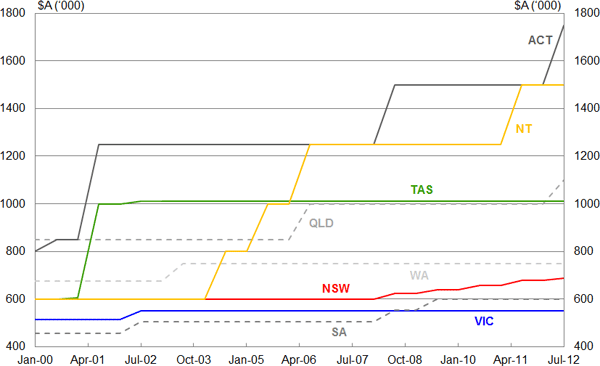
Source: State Revenue Offices, NSW Interstate Comparison of Taxes
(Payroll tax rates 2000-11)
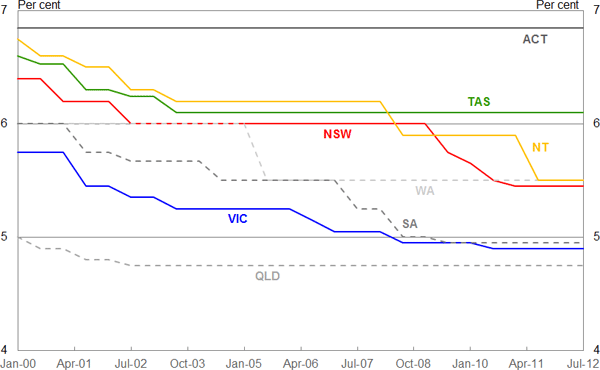
Source: State Revenue Offices, NSW Interstate Comparison of Taxes
The common reason for opposing payroll tax increases is the perception that it is a tax on jobs. This, in fact, is simply confusing the economic and legal incidence of the tax.
Yes, it is businesses that remit payroll tax to the State Revenue Offices on the size of their payrolls. However, the burden of the tax is mostly passed through to workers by way of lower wages than they would otherwise receive. So, in this case, it has substantially the same effect as the personal income tax and the GST, in that the payroll tax also generates revenue by reducing the real after-tax return from working. Of course, the legal incidence varies and the distributional impact is different, but the end results are very similar.
And so, while I've been saying that we need a considered debate on the role and size of government in Australia, what is also required is a conversation about the sustainability of our tax systems at both State and Commonwealth levels. I recognise that this is not easy, but it is critical that Australia has such a debate and that it be informed by some clear analytical thinking.
Such a conversation will also have to cope with the adage that 'tax reform has no constituency' - the opposition from the few with something to lose from tax reform is often louder and more focused than the support that might come from the many who stand to gain from widely diffused benefits.
Australia faced a similar challenge when we began to dismantle the high tariff walls in the 1980s. Few would say today that this was not the right course of action. And it required debate informed by the costs of continued trade protection.
Our history affirms that the best chance of undertaking durable tax reform at Commonwealth and State levels is to ignite a better and broader conversation in the community underpinned by better public understanding about the issues involved. This will require sensible contributions from interested parties, giving credit where credit is due to the actions taken by governments, and acknowledging that none of this is simple.
Conclusion
The main messages I want to leave you with today are that:
- While we are in uncertain times, and global volatility and structural change are likely to endure for the foreseeable future, Australia is in a good position. This is largely attributable to the soundness of our macro-policy framework over the past quarter century, but we cannot be complacent about the basis for this success.
- Importantly, we need to ensure that we maintain the right strategy for medium-term fiscal sustainability - in particular, how we will reconcile increasing demand for government expenditure with the fiscal pressures facing governments at all levels.
- Lastly, there are many opportunities for Australia in the decades ahead.
To reap the full advantage of these opportunities, in a fiscally sustainable way, we need to have a considered, mature national conversation on the role of government, the sustainability of our tax system, and our preparedness for the global changes that are occurring.
If we can't do this, we run the serious risk of being overwhelmed by the challenges we face and missing the opportunities open to us.
Thank you.
1 Based on US Congressional Budget Office estimates.